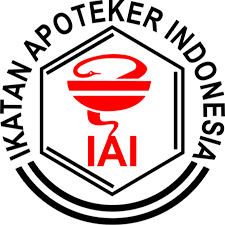Pengaruh Perbedaan Metode Ekstraksi Metabolit Sekunder Streptomyces sp. GMR22 terhadap Toksisitas pada Sel BHK-21
Diani Mentari(1*), Mirtani Naima(2), Riska Wulansari(3), Jaka Widada(4), Tri Rini Nuringtyas(5), Tri Wibawa(6), Nastiti Wijayanti(7)(1) Program Studi D-3 Teknologi Transfusi Darah STIKES Guna Bangsa Yogyakarta
(2) Program Studi Biologi UIN Walisongo Semarang
(3) Program Pascasarjana Fakultas Biologi Universitas Gadjah Mada, Yogyakarta
(4) Fakultas Pertanian, Universitas Gadjah Mada, Yogyakarta
(5) Program Pascasarjana Fakultas Biologi Universitas Gadjah Mada, Yogyakarta
(6) Fakultas Kedokteran, Universitas Gadjah Mada, Yogyakarta
(7) Program Pascasarjana Fakultas Biologi Universitas Gadjah Mada, Yogyakarta
(*) Corresponding Author
Abstract
Streptomyces sp. GMR22 is local isolate from Wanagama 1 Forest in Yogyakarta. They have the potential to be developed to produce active compounds because have PKS and NRPS genes.The active compounds from isolation are strongly influenced by various factors, one of them is extraction techniques. Effect difference of extraction technique will be affected by the quality of secondary metabolites produced.The purpose of this study was to compare the cytotoxicity effects of secondary metabolites of Streptomyces sp. GMR22 which have extracted with different stages from previous studies. The extraction technique was carried out by multilevel separatory funnel extraction methods, which was first extracted using non-polar solvent (n-hexane) and then extracted using semi-polar solvent (ethyl acetate). This research is important because in previous studies (separatory funnel only extracted using ethyl acetate) with the use of the lowest concentration in the dengue virus antiviral test (further test) caused 100% of deaths in BHK-21 cells.This study indicate that multilevel extraction result in lower CC50 value than previous studies. There are 49.160 µl/ml (n-hexane extract) and 284.56 µl/ml (ethyl acetate extract) while water extract is 464,38 µl/ml. FTIR compound analysis show that the three extracts produced have different spectrum patterns, especially in the n-hexane and ethyl acetate extract. Value of CC50 is not too high, it is expected that the secondary metabolites contained in the extracts can be used for further analysis such as antiviral testing because it is safe for normal host cells such as BHK-21 cells
Keywords
Full Text:
PDFReferences
Alberts, B., Johnson A., Lewis, J., Raff, M., Roberts, K. dan Walte, P. 2008. Molecular Biology of The Cell. USA : Gerland Science Fifth Edition.
Alen, M. M. F., dan Schols D. 2012. Review Article: Dengue Virus Entry as Target for Antiviral Therapy. Journal of Tropical Medicine. doi:10.1155/2012/628475
Alimuddin, Jaka Widada, Widya Asmara, dan Mustofa. 2011. Antifungal Production of a Strain of Actinomycetes Spp Isolated from the Rhizosphere of Cajuput Plant : Selection and Detection of Exhibiting Activity Against Tested Fungi. Indonesian Journal of Biotechnology, 16(1): 1–10.
Alimuddin. 2012. Actinomycetes Penghasil Antifungi Rizosfer Tegakan Kayu Putih Hutan Wanagama I Yogyakarta : Isolasi, Optimasi dan Karakterisasi Actinomycetes serta Isolasi Senyawa Antifungi. (Disertasi). Program Studi Bioteknologi Sekolah Pascasarjana. Universitas Gadjah Mada Yogyakarta.
Anonim. 2016. Table of Characteristic IR Absorptions. University of Colorado at Boulder, Department of Chemistry and Biochemistry. http://orgchem.colorado.edu/Spectroscopy/specttutor/irchart.pdf.
Berridge MV, Herst PM, Tan AS. 2005. Tetrazolium Dyes as Tools in Cell Biology: New Insights into their Cellular Reduction. Biotechnology Annual Review.
Chaudhary HS, Soni B, Shrivastava AR, Shrivastava S. 2013. Diversity and Versatility of Actinomycetes and its Role in Antibiotic Production. Journal of Applied Pharmaceutical Science. 3 : S83-S94.
Gopinath B.V, dan Charya M.A.S. 2013. Characterization of Antibacterial Compounds Produced by The Actinomycetes using NMR Spectral Analysis. International Journal of Pharma Sciences and Research (IJPSR). 4(2).
Harborne, J.B. 1983. Metode Fitokimia : Penuntun Cara Modern Menganalisis Tumbuhan. ITB Pree. Bandung.
Imaniar NI. 2014. Marine and Soil Actinomycetes Secondary Metabolite Antivirus Activity Against Dengue Serotype-1 Virus. (Thesis) Biotechnology Graduate School of Universitas Gadjah Mada Yogyakarta Indonesia
Jindo K, Mizumoto H, Sawada Y, Sanchez-Monedero M. A dan Sonoki T. 2014. Physical and Chemical Characterizations of Biochars Derived from Different Agricultural Residues. Biogeosciences Discuss. 11: 11727–11746
Kennedy, L. J., Vijaya, J. J., Sekaran, G., 2005, Electrical conductivity study of porous carboncomposite derived from rice husk, Mater. Chem. Phys., 91. pp. 471–476.
Marbawati D, Sardjiman, Yulianti R. 2014. Efektivitas Pentagamavunon-0 (PGV-0) pada Fase Awal Infeksi Virus Dengue-2. Aspirator. 6 (2): 43-48.
Nurjasmi, Reni, and et al. 2009. Diversity of Actinomycetes at Several Forest Types in Wanagama I Yogyakarta and Their Potency as a Producer of Antifungal Compound. Indonesian Journal of Biotechnology. 14(2): 1196–1205.
Pavia, D.L., Lampman, G.M., Kriz G.S dan Vyvyan J.R. 2001. Introduction to Spectroscopy. Fourth Edition. Departemant of Chemistry. Western Washington University Bellingham. Washington Rante H. 2012. Isolasi dan Karakterisasi Actinomycetesasosiasi Spons Penghasil Antibiotik Koleksi Pulau Barrang Lompo Makassar. Disertasi. Ilmu Farmasi. Universitas Gadjah Mada. Yogyakarta.
Praditya DF. 2014. Potential Ethyl Asetat Extracts Of Secondary Metabolit Aktinomisetes to Againt Virus Dengue Serotype-2 (DENV-2). Thesis.BiotechnologyGraduate School of Universitas Gadjah Mada YogyakartaIndonesia
Socrates, G. 2007. Infrared and Raman Characteristic Group Freuencies Tables and Charts Third Edition. John Wiley & Sons, Ltd: United States.
Zhu, K., Fu, H., Zhan, J., Lv, X., Tang, J., Xu, X., 2012, Studies on removal of NH4–N from aqueous solution by using the activated carbons derived from rice husk, Biomass Bioenergy, 43. pp.18–25.
Article Metrics
Abstract view(s): 2083 time(s)PDF: 3718 time(s)
Refbacks
- There are currently no refbacks.








